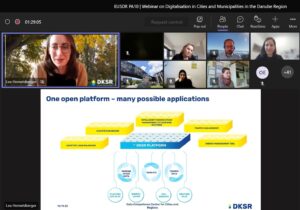Smart cities are a well-known approach in Europe. But how smart are our villages? In 2018, three Directorates General (DG MOBILITY, DG AGRI, DG REGIO) of the European Commission teamed up to boost Smart Villages. In the following, municipalities in Europe launched their first smart village initiatives. While the approach gained momentum in the Alpine Region, Central and Eastern European villages mainly gave a pass to the concept. However, scarce financial resouces in local administrations, the rising demand for participation and transparency, and – finally – the rise of digitalisation during the COVID-19 pandemic is a good starting point to have another look at the idea.
Hence, on 10 November 2022, Priority Area 10 “Institutional Capacity” hosted the third edition of the Strategic Projects webinar series. The webinar provided information on “Digitalisation in cities and municipalities”. This time, experts talked about:
- What makes a village “smart”?
- How can villages learn from smart cities?
- Which factors make a smart village a success?
- Where do municiaplities get financial support to launch their own smart village project?
What is a smart village?
Smart villages bring together citizens participation and digital technologies in rural communities. The aim is to improve resilience and quality of life in villages and municipalities. In doing so, smart village initiatives explore various potentials of digitalisation in different spheres of life such as mobility, environmental protection, labour market, administrative procedures, food security etc. Likewise, involving people in the decision-making and design of digital services is a key factor of smart villages. This way, communities ensure that the implemented measures meet the need of their users.
Edina Ocsko (e40 group) presented the emergence of the smart village approach in Europe, starting with the EU Action for Smart Villages in 2017. With the SMART RURAL 21 project, Edina and her team launched a smart village mapping exercise. In doing so, the project identified smart villages and promoted the approach throughour Europe. The SMART RURAL 21 project started with 21 villages. By the end of the project, the consortium welcomed ca. 200 villages across Europe to their network. One of the project outputs was a guidebook on how to implement the smart village approach in order to inspire more rural communities.
The follow-up project SMART RURAL 27 aimed at preparing EU members states for the implementation of the Common Agricultural Policy (CAP) 2021-2027. This time, the project provided policy recommendations on how to support smart rural communities.
Those projects provided some useful ground work to gain insights into different application areas for smart village initiatives. In particular, rural communities that look for good practices on how digital technology and citizens participation work together, find inspiration.
Digitalising administration for better policies – Learning from Smart Cities
Lea Hemetsberger (DKSR – Data Competence for Cities and Regions) talked about how data platforms facilitate administartive procedures and participation processes in cities and municipalities. Collecting and processing data can help to develop solutions that address challenges in infrastructure, spatial planning, health, and many more. Especially, small and medium-sized cities face challenges, where digital or hybrid solutions could help.
 Thereby, event solutiond from bigger cities can be an inspiration for smaller municipalities. One of these esamples is BRISE Vienna. BRISE is a building regulations system for submission evolvement. Its aim is to speed up the planning permission process and the quality of files and documents. The system uses 3D models, augmented reality and artificial intelligence. In doing so, the application can also facilitate communication in participation processes by making the projects more tangible.
Thereby, event solutiond from bigger cities can be an inspiration for smaller municipalities. One of these esamples is BRISE Vienna. BRISE is a building regulations system for submission evolvement. Its aim is to speed up the planning permission process and the quality of files and documents. The system uses 3D models, augmented reality and artificial intelligence. In doing so, the application can also facilitate communication in participation processes by making the projects more tangible.
A different example comes from Germany, Ilzer Land, that introduced a hybrid citizens participation platform. This initiative tackles the challenge of encouraging more citizens in rural areas to share their ideas on how to develop the community.
Equally, data platforms can help rural communities to cope with extreme weather conditions, improve infrastructure management and in various other sectors. Lea Hemetsberger also stressed the advantage of working in data communities as they boost innovation capacity, strengthen citizen-centric data application, and provide an opportunity to collaborate across cities and regions.
European Transnational Cooperation for Smart Villages – sharing success factors
With the SMARTvillage project, the Swiss Working Community for Mountain Regions and its project partners aimed at promoting the smart village approach in the Alpine Region. At the webinar, Peter Niederer (SAB) shared his experiences from the Interreg Alpine Space project. Thereby, he pointed out common success factors, such as citizens engagement or adding external expertise. Furthermore, he stressed that smart solution need to actually relieve local authorities from tasks in order to be accepted.
Likewise, municipalities have the advantage that they are very fast in decision-making and often show readiness to be pioneers. Finally, Peter Niederer encouraged to stay open for extra-ordinary ideas. Drawing from hin experience in the project, fostering a culture of “disturbance” prompts innovative out-of-the-box-thinking and promotes innovation.
Similarly, transnational cooperation supports mutual learning and building on good practice innovations from other rural communities. However, the project also revealed that transnationale exchange needs a lot of support. In particular, language barriers may hamper close cooperation across borders.
Where do we find funding for Smart Villages?
Michael Gansch (EuroVienna) and Johannes Gabriel (Interreg Danube Region Programme) presented funding options for those, who are interested in implementing a smart village project.
The European Union provides a number of financing instruments that support smart village initiatives or activities within smart village strategies.
Hence, Michael Gansch presented the EU funding and Tender Portal to look up open calls for proposals or tenders.
In addition, the Funding Database EuroAccess Macro Regions provides information on EU programmes and calls for procedures. Due to the filter functions, users can customise their search and subscribe to a customised newsletter that sends information on relevant calls.
Regarding EU Funding, the Horizon Europe Programme, Digital Europe Programme, LIFE, European Urban Initiatives, and URBACT provide related funding to promote and develop smart village solutions.
Moreover, the Interreg programmes support relevant initiatives in their funding priorities on smarter, greener or better connected Europe.
Finally, Johannes Gabriel presented the support from the Interreg Danube Region Programme in more detail. In particular, the specific objective on institutional capacities for territorial and macro-regional governance addresses demographic and territorial challenges. The focus lies – amongst others – on improving public services of general interest and digitalisation.
The webinar on “Digitalisation in cities and municipalities” is from the ‘Strategic Project Webinar’ series. All documents presented at the webinar are accessible on our website.
The ‘Strategic Project Webinars’ are a series of webinars that address questions on funding and provides practical insights in project development for topics related to the actions of Priority Area 10 “Institutional Capacity and Cooperation”. Our aim is to provide concrete and practical information and tips to support our stakeholders in developing strategic projects. Thereby, we provide a compact overview on state of the art expertise and relevant financing opportunities. Likewise, we want to encourage networking and match-making of partners.
Links




